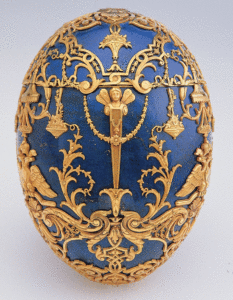
If Lapis Lazuli had been brown in color, it would not have been as popular, or even known that much in today’s market. Because of the blue color, which some coined “sapphire” in antiquity, the allure was strong to use the brightly colored rock in many shapes, forms and styles of art, furniture, ceremonial pieces and more.
Lapis Lazuli means stone of blue in Greek and Latin roots, and Lapis Lazuli is a compound made up of lazurite, a feldspar silicate.
It originates in Afghanistan and is known for its blue color.
Lapis has been used in pigment paint coloring, inlay on antique furniture, frames, boxes and even tombs of the Pharaohs of ancient Egypt.
Lapis Lazuli is found as a component imbedded in limestone in northeastern Afghanistan, where mine deposits have been worked for more than 6,000 years.
Ancient Egyptian, Mesopotamian, Greek and Roman civilizations obtained the bright blue rock from this region for their art and other uses.
Trade routes were established near the mines since the Neolithic age for these ancient civilizations to procure the stunning stone. Lapis is also found in other places on the planet, but in smaller quantities.
Some of the first uses of the blue stone were used for inlay of ancient worshipping figures, beads, jewelry components and handles of ceremonial knives.
In the ancient poems of Epic of Gilgamesh, circa 17th century BCE, lapis lazuli is mentioned several times, showing its importance as a revered item in decoration to these early civilizations.
The early Syrians used lapis lazuli as inlay for things like irises of the eyes in statues, inlay in ancient jewelry, and trade beads.
Myceanaen jewelry from the people to the East of Egypt show the influence and allure of the magical blue mineral and the captive audience in which it held sway.
Egyptians prized lapis for its color and was a favorite stone, especially for amulets and ceremonial scarab jewelry.
One of the most famous uses of lapis lazuli ever is the iconic mask of King Tut, layered in blue rows of lapis lazuli.
Powdered lapis was even used as an eyeshadow for Cleopatra, and relief carvings in the tomb of Thutmose III show lapis being given to him as a tribute, precious as it was in those days.
In the Middle Ages lapis lazuli was called sapphire, and was used to decorate many pieces of jewelry.
The inlay of jewelry with lapis had been done since early times, but the middle ages showed many skilled craftsmen using the stone to enhance beautiful objects with the blue from the earth.
There are even references to lapis in the Old Testament of the Bible.
Lapis Lazuli was crushed into powder to give the famous bright blue colorization to paintings of the Renaissance.
It was ground into pigments for use in oil painting and frescoes of the time period.
The blue lapis created was the finest of all blue pigments, as it was expensive. It was used and reserved for central figures in a painting, such as the Virgin Mary.
It was used less as pigments for oils as the color became chemically synthesized in the 19th century.
Today the powdered version of lapis, called ultramarine, costs over one thousand dollars a pound.
In the antiques world, one can find lapis made into boxes, carvings, mosaics, ornamental décor of all types, statues, vases, ashtrays, and many, many pieces of jewelry, as well as furniture inlay.
True lapis lazuli boxes and items with heavy lapis work sell for big money in the antiques market, even today.
Lapis is a porous stone which can be easily dyed.
There is a way to synthesize lapis using something called the Gilson process, which makes artificial ultramarine color with zinc phosphates.
Other stones can also be dyed, such as the less expensive howlite and sodalite, and are made to mimic and imitate lapis.
If Lapis Lazuli had been brown in color, it would not have been as popular, or even known that much in today’s market.
Because of the blue color, which some coined “sapphire” in antiquity, the allure was strong to use the brightly colored rock in many shapes, forms and styles of art, furniture, ceremonial pieces and more, before the advent of chemical processes that copy nature.
To view masterful works of art using the bright blue stone, one can see how the ancients, and more modern artisians as well, were mesmerized by a stone of beauty from the earth.



